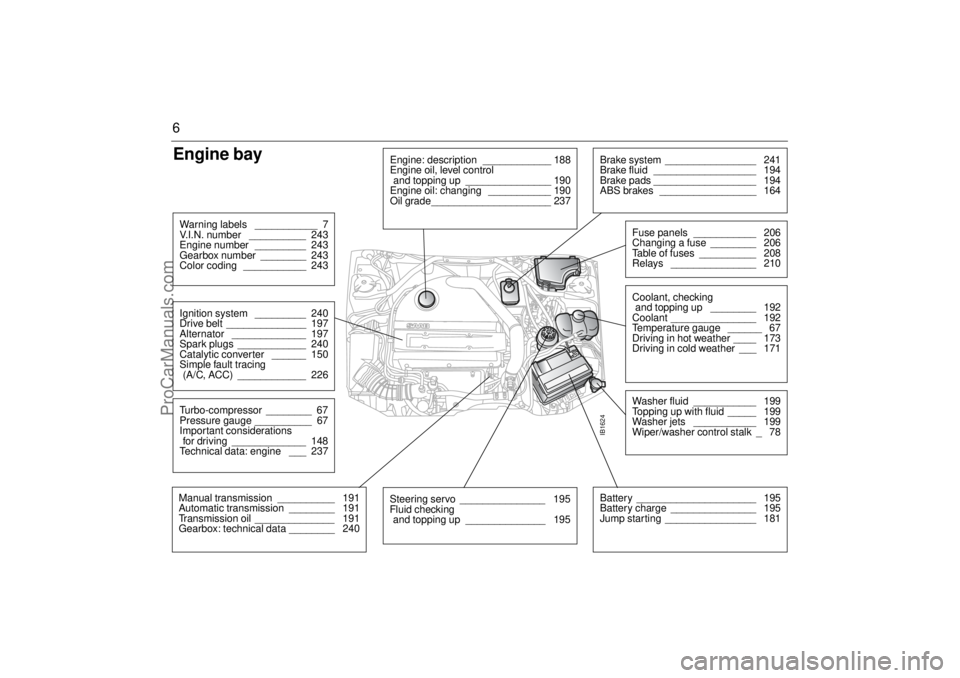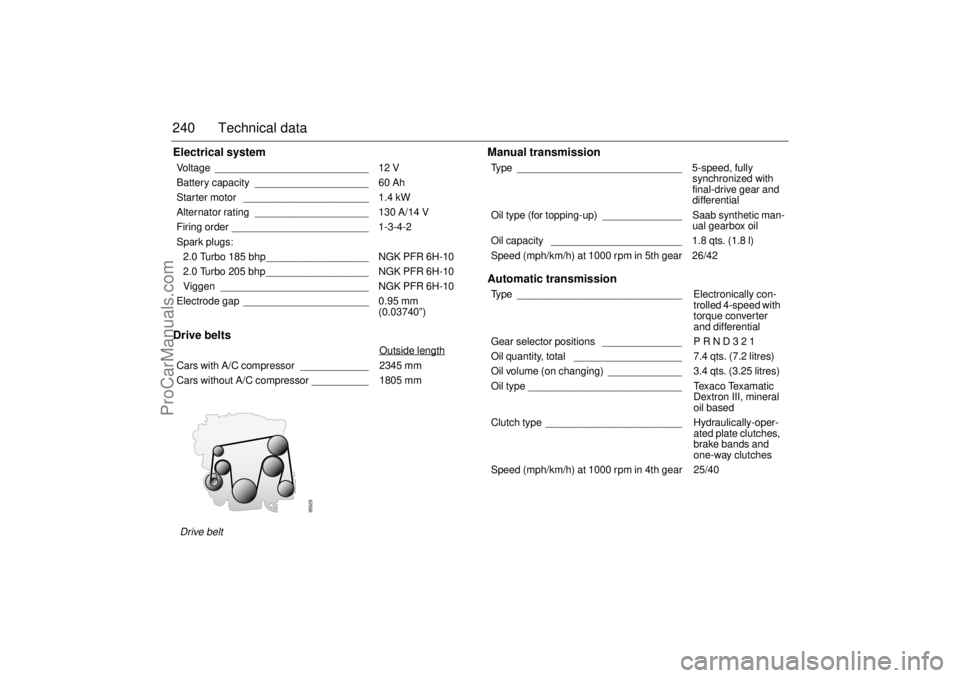spark plugs SAAB 9-3 2002 Owners Manual
[x] Cancel search | Manufacturer: SAAB, Model Year: 2002, Model line: 9-3, Model: SAAB 9-3 2002Pages: 256, PDF Size: 11.55 MB
Page 6 of 256

6Engine bayWarning labels ___________ 7
V.I.N. number __________ 243
Engine number _________ 243
Gearbox number ________ 243
Color coding ___________ 243Ignition system _________ 240
Drive belt ______________ 197
Alternator _____________ 197
Spark plugs ____________ 240
Catalytic converter ______ 150
Simple fault tracing
(A/C, ACC) ____________ 226Turbo-compressor ________ 67
Pressure gauge __________ 67
Important considerations
for driving _____________ 148
Technical data: engine ___ 237Manual transmission __________ 191
Automatic transmission ________ 191
Transmission oil ______________ 191
Gearbox: technical data ________ 240
Battery _____________________ 195
Battery charge _______________ 195
Jump starting ________________ 181IB1624
Engine: description ____________ 188
Engine oil, level control
and topping up _______________ 190
Engine oil: changing ___________ 190
Oil grade_____________________ 237
Washer fluid ___________ 199
Topping up with fluid _____ 199
Washer jets ___________ 199
Wiper/washer control stalk _ 78
Steering servo _______________ 195
Fluid checking
and topping up ______________ 195
Coolant, checking
and topping up ________ 192
Coolant _______________ 192
Temperature gauge ______ 67
Driving in hot weather ____ 173
Driving in cold weather ___ 171Fuse panels ___________ 206
Changing a fuse ________ 206
Table of fuses __________ 208
Relays _______________ 210
Brake system ________________ 241
Brake fluid __________________ 194
Brake pads __________________ 194
ABS brakes _________________ 164
ProCarManuals.com
Page 148 of 256

148 Starting and drivingStarting the engine The engine has an automatic choke and
should be started as follows:
Cars with manual gearbox
To start the engine the clutch pedal must
be fully depressed.
1 Depress the clutch pedal but do not
touch the accelerator.
2 Start the engine. Let the ignition key
spring back as soon as the engine has
started and is running smoothly – at very
low temperatures, you may need to run
the starter for up to 50 seconds.
Let the engine idle for about 10 seconds. Do
not open the throttle wide for at least
2-3 minutes after starting.
Cars with automatic transmission
The selector lever must be in the P or N
position.
1 Keep your foot on the brake pedal.
2 Start the engine. Let the ignition key
spring back as soon as the engine has
started and is running smoothly – at very
low temperatures, you may need to run
the starter for up to 50 seconds.
Let the engine idle for about 10 seconds. Do
not open the throttle wide for at least
2–3 minutes after starting.
Useful tips on cold climate startingIf the engine has failed to start after several
attempts in very cold weather, press and
hold the accelerator down to the floor and
run the starter for 5–10 seconds. This will
prevent the engine being flooded (exces-
sively rich fuel-air mixture).
Now start the engine in the normal way – do
not touch the accelerator.
If the engine stalls immediately after starting
(e.g. if the clutch was released too quickly),
do not touch the accelerator when restarting
the engine.
Every time the engine is switched off the
spark plugs are automatically cleaned. If
your attempt to start nevertheless fails, let
go of the ignition key and allow it to spring
back. This initiates more vigorous cleaning
of the sparking plugs which goes on for
about 5 seconds. Then start in the ordinary
way. Do not touch the accelerator; if the
accelerator is pressed to the floor the fuel
supply is shut off.
Important
considerations for
drivingThe engine-management system in the
Saab 9-3 is called Saab Trionic T7. The
system manages the ignition, fuel injection
and turbo boost pressure.
The Trionic T7 system developed by Saab
is an intelligent engine-management
system designed to achieve optimum drive-
ability under differing driving conditions.
The system makes adjustments automati-
cally, for instance, if the car is being driven
at altitude (oxygen-deficient air), for differ-
ent grades of fuel (AON 87–93) and for dif-
ferent load conditions.
1 Starting and driving
Refrain from using full throttle before
the engine has warmed up (before
needle is in the mid-range on tempera-
ture gauge) to avoid unnecessary
wear. If the needle of the pressure
gauge repeatedly enters the red zone
the engine may suddenly lose power,
owing to the intervention of a monitor-
ing system which curtails the charging
pressure. Get in touch with an autho-
rized Saab dealer at once.
A safety function prevents the engine
from reving faster than 6,200 rpm by
temporarily shutting of the fuel injec-
tors.
ProCarManuals.com
Page 240 of 256

240 Technical dataElectrical system
Drive belts
Manual transmission
Automatic transmission
Voltage ___________________________ 12 V
Battery capacity ____________________ 60 Ah
Starter motor ______________________ 1.4 kW
Alternator rating ____________________ 130 A/14 V
Firing order ________________________ 1-3-4-2
Spark plugs:
2.0 Turbo 185 bhp__________________ NGK PFR 6H-10
2.0 Turbo 205 bhp __________________ NGK PFR 6H-10
Viggen __________________________ NGK PFR 6H-10
Electrode gap ______________________ 0.95 mm
(0.03740”)
Outside lengthCars with A/C compressor ____________ 2345 mm
Cars without A/C compressor __________ 1805 mmDrive belt
IB929
Type _____________________________ 5-speed, fully
synchronized with
final-drive gear and
differential
Oil type (for topping-up) ______________ Saab synthetic man-
ual gearbox oil
Oil capacity _______________________ 1.8 qts. (1.8 l)
Speed (mph/km/h) at 1000 rpm in 5th gear 26/42
Type _____________________________ Electronically con-
trolled 4-speed with
torque converter
and differential
Gear selector positions ______________ P R N D 3 2 1
Oil quantity, total ___________________ 7.4 qts. (7.2 litres)
Oil volume (on changing) _____________ 3.4 qts. (3.25 litres)
Oil type ___________________________ Texaco Texamatic
Dextron III, mineral
oil based
Clutch type ________________________ Hydraulically-oper-
ated plate clutches,
brake bands and
one-way clutches
Speed (mph/km/h) at 1000 rpm in 4th gear 25/40
ProCarManuals.com